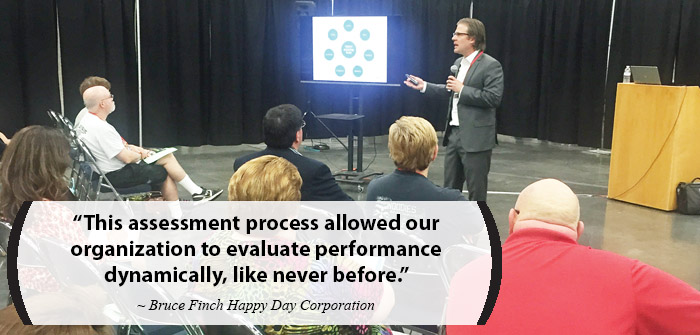(Photo above: Todd Montgomery speaking at the 2015 Northwest Food Show in Portland | by Gene Fritz)
Research helps Happy Day Corporation restaurants increase profits by 33 percent.
Happy Day Corporation owns and manages twelve full-service and quick-service restaurants in the Pacific Northwest. Created by veteran restaurant management professional and entrepreneur Bruce Finch, Happy Day Corporation serves as the primary innovator and market driver within the region. The company manages a growing portfolio of restaurants that include Tomato Brothers, Zany Graze, Main Street Grill, Southway Pizzeria and Deli, Taco Time, Arby’s and A&W restaurants.
Happy Day Restaurants has been operating since 1969. Being an older regional leader, the restaurant group has been challenged to maintain market share in a growing region.
Finch says, “competition is fierce in the markets we serve and we needed to find efficiencies and profits in places that traditional restaurants don’t typically look. As a result, we looked for a partner to help support us in this initiative who specialized in using data to optimize performance within the restaurant industry and this led us to Todd Montgomery of Oregon State University – Cascades and Gene Fritz of the Art Institute of Portland.
“After our first meeting, it became clear that we had to start leveraging technology and use data to drive our daily decision making in every facet of our restaurant. The restaurant industry is traditional and typically decisions are driven by tradition and gut feel.”
Finch says, “this assessment process allowed our organization to evaluate performance dynamically, like never before. Access to this process gave our front-line managers insight as to how they can increase operational effectiveness and have an immediate and ongoing impact upon profitability.”
Montgomery adds, “Bruce Finch is a true innovator. I’ve been working on projects like these for over 20 years. Each time, it came down to the leader of the organization and whether they were committed to change or not. Bruce saw an opportunity to make a very successful organization even more profitable, and he seized it.”
The positive results were almost immediate. Within two months, Happy Day Corp started seeing significant lifts in profits in each area of the restaurant.
Finch says, “having partners available in education who specialize in these areas cannot be overstated. They provided tremendous insight and measurable results. They also allowed us to do what we do best and that is providing excellent service and food.”
Happy Day Restaurants is already looking to build on their initial success. To do so, they plan to take these proven concepts and apply them to each facet of their operations. One area of particular interest is to better understand their customers price elasticity for individual items. As gas prices continue to fluxuate, restaurant customers across the nation are altering their consumer spending behavior. Happy Day Restaurants are also looking to improve their customer demand forecasting by incorporating weather patterns and regional event calendars that influence business.
Todd Montgomery and Gene Fritz presented the results and discussed the project in detail to attendees of the 2015 Northwest Food Show in Portland.
http://nwfoodserviceshow.com/wp-content/uploads/2015/04/SHOW-GUIDE-040915-Smallest.pdf (page 13)





